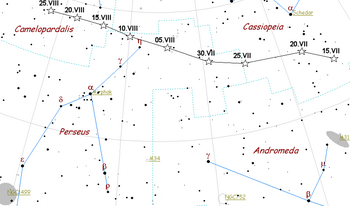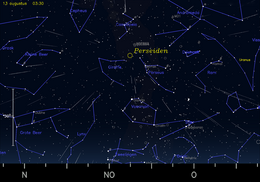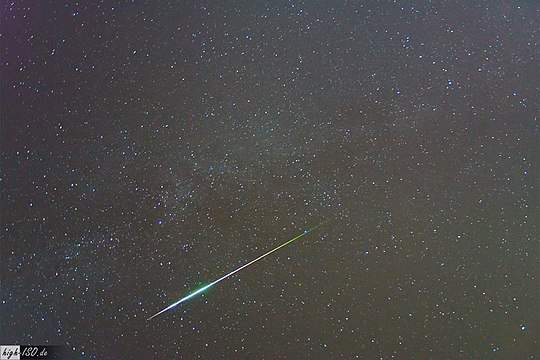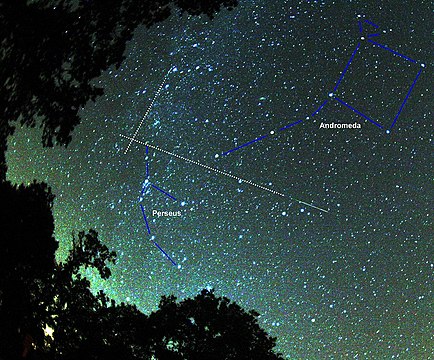Perseids
| Perseids | |
|---|---|
| Activity period | July 17th - August 24th |
| Activity maximum | 12. August |
| Radiant position of the maximum activity |
RA : 3h 12m DE : + 58 ° |
| ZHR | 100 |
| Population index r | 2.2 |
| geocentric speed | 59 km / s |

|
|

|
|
The Perseids [ pɛɐ̯zeˈʔiːdn̩ ] ( Laurenti tears , tears of Laurentius ) are a meteor shower that recurs annually in the first half of August, with a clear maximum of falling stars in the days around August 12th . As so-called fireballs , they often even reach the brightness of Venus . The radiant , the apparent origin of this current, lies in the eponymous constellation Perseus , near the border with Cassiopeia .
story
The first recorded observation of the Perseids took place about two millennia ago around 36 BC. In China . Then there were reports from Japan and Korea . The first observation in Europe was made in 811. The first known written record from the book Introduction a la Philosophie naturelle by the Dutch naturalist Pieter van Musschenbroeck stems from 1762 that the increased August meteorite activity is an annually recurring event. He describes that after the summer heat, falling stars can be seen in Belgium and the Dutch cities of Leiden and Utrecht . In 1792 there are in Pennsylvania - Newspaper National Gazette an article to increased meteor activity on 15 August. Literally it says, "in the month of August there are more meteors to be Observed in the atmosphere, than at any other period of the year ...." The English naturalist Thomas Forster writes in his book The Pocket Encyclopedia of Natural Phenomena for 10 . August of 1827 ". Falling Stars and meteors abound about this time of year" in 1835, the Belgian astronomer and statistician wrote Adolphe Quetelet a written report of a meteor shower in the constellation Perseus. He was the first astronomer to connect the radiant of the August meteor shower with the constellation Perseus .
Since the appearance of the Perseids coincides with the feast of the martyr Lawrence on August 10th , who suffered his martyrdom on a glowing grate in 258, they are popularly known as Laurenti tears or tears of Laurentius .
In the 19th century, the maximum number of Perseids was probably 1–2 days earlier than it is today: in Eduard Heis 1839–49 on August 11, in Wilhelm Meyer around August 10.
Origin and occurrence

The Perseids consist of the dissolution products of comet 109P / Swift-Tuttle . On its orbit, the earth always crosses the dust trail that this comet has left in space around August 12th. The dust particles hit the atmosphere at high speed and make the air molecules glow. The shooting star is therefore not the glowing speck of dust itself, but becomes visible through the recombination glow of the ionized air.
The entire period of activity of the Perseids extends from July 17th to August 24th. The number of meteors always increases when the earth comes particularly close to the earlier comet in its orbit, as was the case in 1992. In the years 1991 to 1993 rates of more than 350 meteors per hour under ideal conditions ( ZHR ) could be registered.
visibility
In densely populated areas of mid- latitude , the maximum fall rate is usually 20 to 50 Perseids per hour. The ZHR of 100 to 120, which is often mentioned in the media , is practically never reached in Central Europe for several reasons:
- A ZHR of 100–120 is only valid on the day of the maximum (August 12th to 13th), but
- only for the best atmospheric conditions (without moonlight and scattered light) with a visibility of stars 6th to 7th magnitude , which can only be found in high mountains and dry desert areas.
- The constellation Perseus, from which the meteors seem to come, does not culminate at the time of maximum until between 6 and 7 a.m. summer time (CEST) . It is then almost at the zenith , but it starts to get light at 3 to 4 a.m. (however, this applies to all places where Perseus can stand near the zenith, as the angular distance between Perseus and the sun is only 80 ° at the beginning of August).
The best observation time is between around 2 and 4 a.m., when Cassiopeia is almost at its zenith and Perseus is around 20 ° lower in the east. Most of the Perseids can be seen during this period, because their radians lie in the starry sky in the direction of the Earth's movement (i.e. they run directly into the Perseids swarm). Even in the days before and after, 10-30 Perseids per hour can be seen after midnight.
The Perseids are among the most impressive swarms of shooting stars and have produced some exceptional events in history. As with any other meteor shower, you should go to the darkest possible environment to observe the Perseids and not look directly at Perseus. Instead, the line of sight should be 20 to 40 ° away from the radian in order to be able to see the long, rapidly moving tracks to the side. With increasing proximity to the radiant, the traces of light become shorter and brighter, which is why they are also called Laurenti tears (commemoration day on August 10th).
In 2018, the maximum was reached on the night of August 13th. The best observation time is always in the second half of the night.
In some years the particle cloud is denser than usual where the earth crosses the comet's orbit. B. the case in the late evening of August 12, 2018, where hourly fall rates of up to 100 meteors also occurred in Central Europe .
Historical development
| year | Activity period | Period of the maximum rate |
comment |
|---|---|---|---|
| 2020 | July 17th - August 24th | 12./13. August (ZHR max 88) | |
| 2019 | July 17th - August 24th | 12./13. August ( ZHR max 71) | Full moon on August 15th |
| 2018 | July 17th - August 24th | 12./13. August (ZHR max 81) | New moon on August 11th |
| 2017 | July 17th - August 24th | 12./13. August (ZHR max 78) | |
| 2016 | July 17th - August 24th | 11./12. August (ZHR max 180) | |
| 2015 | July 17th - August 24th | 12./13. August (ZHR max 107) | New moon on August 14th |
| 2014 | July 17th - August 24th | August 13 (ZHR max 92) | Full moon on August 10th |
| 2013 | July 17th - August 24th | August 12 (ZHR max 148) | |
| 2012 | July 17th - August 24th | August 12 (ZHR max 153) | |
| 2011 | July 17th - August 24th | August 12 (ZHR max 91) | Full moon on August 13th |
| 2010 | July 23rd - August 24th | August 12 (ZHR max 142) | |
| 2009 | July 14th - August 24th | August 13 (ZHR max 173) | the expected maximum was 173, but visibility was reduced by the waxing moon |
| 2008 | July 25th - August 24th | August 13 (ZHR max 116) | |
| 2007 | July 19 - August 25 | August 13 (ZHR max 93) | |
| 2006 | August 12 ( ZHR max 90) | ||
| 2005 | August 12 ( ZHR max 102) | ||
| 2004 | August 12 (ZHR max 247) | ||
| 1994 | (ZHR max > 200) | ||
| 1993 | (ZHR max 200-500) | ||
| 1992 | Outbreak on August 11th | Full moon on August 13th | |
| 1864 | (ZHR max > 100) | ||
| 1863 | (ZHR max 109–215) | ||
| 1861 | (ZHR max 78-102) | ||
| 1858 | (ZHR max 37-88) | ||
| 1839 | (ZHR max 165) | ||
| 1792 | 15th of August |
Recordings
The radian lies at the intersection of the white lines.
A real-time Perseid meteor. The greenish recombination glow of the tail in the mesosphere is visible for about 0.7 seconds.
( Variant of the recording in ten times slow motion. )Video of two Perseid meteors and a satellite in the constellation Swan, recorded in the Westhavelland International Star Park on August 12, 2020
Image taken from space on the International Space Station in August 2011
See also
- Outgassing
- Aquariids / Aquarids
- Geminids
- meteorite
literature
- Eva Ahnert-Rohlfs : On the structure of the origin of the Perseidenstrom (= publication of the Sonneberg observatory . Volume 2, issue 1). Akademie-Verlag, Berlin 1952, DNB 450034607 pp. 5-38.
Web links
- Coming Perseid Meteor Storms ( Memento from February 6, 2015 in the Internet Archive )
- General information, history and links
- Society for Astronomical Education Landesverband Sachsen-Anhalt: observation tips and general information
- Map with radian positions
- Animation: Perseïden meteor shower. Space Image of the Day, August 8, 2018
Individual evidence
- ↑ IMO Meteor Shower Calendar 2020 , accessed on April 16, 2020
- ↑ The Perseids are Coming!
- ↑ Fireworks in the night sky - Tagesspiegel from August 10, 2010
- ↑ Dr. Bill Cooke: NASA Chat: Stay 'Up All Night' to Watch the Perseids! . NASA. August 11, 2012. Retrieved August 16, 2013.
- ↑ a b c d e f g h Gary W. Kronk : Observing the Perseids . Meteor Showers Online. Archived from the original on June 23, 2013. Retrieved on August 12, 2009.
- ↑ Der Laurentiustrom , in: Vossische Zeitung , August 8, 1902.
- ↑ Falling stars (left column) with the eponymous reference to Laurentius, Berliner Tageblatt , August 9, 1905.
- ^ Wilhelm Mayer: Kometen und Meteore (Kosmos / Franckh ~ 1900), p. 61f.
- ^ The Perseids , accessed March 13, 2015.
- ↑ The Perseids - The Tears of Laurentius: Visibility , WAA Astropraxis online (with sky maps)
- ↑ Visual meteor observation - preparation ( Memento from August 12, 2014 in the Internet Archive ), International Meteor Organization
- ↑ The night of the shooting stars
- ↑ Perseids 2020 campaign. Retrieved September 11, 2020 .
- ↑ Perseids 2019 campaign. Retrieved April 16, 2020 .
- ↑ Perseids 2018 campaign. Retrieved August 14, 2019 .
- ↑ Perseids 2017 campaign. Retrieved August 14, 2019 .
- ↑ Perseids 2016 campaign. Retrieved August 14, 2019 .
- ↑ Perseids 2015 campaign . Imo.net. Retrieved August 14, 2019.
- ↑ Perseids 2014 campaign . Imo.net. August 14, 2019.
- ↑ Perseids 2013 campaign . Imo.net. August 14, 2019.
- ↑ Perseids 2012 campaign . Imo.net. August 14, 2019.
- ↑ Perseids 2011 campaign . Imo.net. August 14, 22019.
- ↑ How to See the Best Meteor Showers of the Year: Tools, Tips and 'Save the Dates' . nasa.gov. Retrieved November 16, 2010.
- ↑ How to See the Best Meteor Showers of the Year: Tools, Tips and 'Save the Dates' . nasa.gov. Retrieved August 12, 2010.
- ↑ Perseids 2009: visual data quicklook . Imo.net. April 26, 2010. Archived from the original on October 16, 2016. Retrieved on August 11, 2009.
- ↑ a b Perseids 2008: visual data quicklook . Imo.net. June 6, 2009. Archived from the original on October 24, 2016. Retrieved on August 11, 2009.
- ↑ a b Perseids 2007: first results . ( Memento from September 27, 2011 in the Internet Archive ) imo.net
- ↑ Perseids 2006 campaign. (No longer available online.) Formerly in the original ; accessed on August 13, 2017 . ( Page no longer available , search in web archives ) Info: The link was automatically marked as defective. Please check the link according to the instructions and then remove this notice.
- ↑ Perseids 2005 campaign. (No longer available online.) Formerly in the original ; accessed on August 13, 2017 . ( Page no longer available , search in web archives ) Info: The link was automatically marked as defective. Please check the link according to the instructions and then remove this notice.
- ↑ Perseids 2004 campaign. (No longer available online.) Formerly in the original ; accessed on August 13, 2017 . ( Page no longer available , search in web archives ) Info: The link was automatically marked as defective. Please check the link according to the instructions and then remove this notice.
- ^ A b Brown: The Perseids 1992. New outburst announces return of P / Swift-Tuttle . In: WGN, The Journal Of IMO . August. bibcode : 1992JIMO ... 20..192B .
- ↑ The Perseids are Coming!
- ↑ Fireworks in the night sky - Tagesspiegel from August 10, 2010








